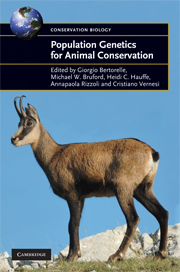Book contents
- Frontmatter
- Epigraph
- Contents
- List of contributors
- Foreword
- Acknowledgements
- 1 Introduction
- Statistical approaches, data analysis and inference
- Molecular approaches and applications
- From genetic data to practical management: issues and case studies
- 10 Future-proofing genetic units for conservation: time's up for subspecies as the debate gets out of neutral!
- 11 Genetic diversity and fitness-related traits in endangered salmonids
- 12 Genetics and conservation on islands: the Galaápagos giant tortoise as a case study
- 13 Evolution of population genetic structure in marine mammal species
- Future directions in conservation genetics
- Software index
- Species index (common name)
- Species index (Latin name)
- Subject index
11 - Genetic diversity and fitness-related traits in endangered salmonids
from From genetic data to practical management: issues and case studies
Published online by Cambridge University Press: 05 July 2015
- Frontmatter
- Epigraph
- Contents
- List of contributors
- Foreword
- Acknowledgements
- 1 Introduction
- Statistical approaches, data analysis and inference
- Molecular approaches and applications
- From genetic data to practical management: issues and case studies
- 10 Future-proofing genetic units for conservation: time's up for subspecies as the debate gets out of neutral!
- 11 Genetic diversity and fitness-related traits in endangered salmonids
- 12 Genetics and conservation on islands: the Galaápagos giant tortoise as a case study
- 13 Evolution of population genetic structure in marine mammal species
- Future directions in conservation genetics
- Software index
- Species index (common name)
- Species index (Latin name)
- Subject index
Summary
INTRODUCTION
An individual's fitness can be largely influenced by its genetic diversity. Low survival and poor fecundity are just few examples of the consequences of the loss of genetic variation (Mitton 1993; Falconer and Mackay 1996). Matings between closely related parents can result in progeny with lowered fitness, a phenomenon generally known as inbreeding depression (Lynch and Walsh 1998). However, genetic drift in small and isolated populations can also result in increased homozygosity, even in the absence of matings between close kin (Shields 1993). On the other hand, matings between genetically differentiated populations or strains often produce individuals with higher fitness during the first generation; a phenomenon called heterosis (Mitton 1993).
The earliest observations of the strong influence of an individual's genetic diversity on its fitness came from domestic and laboratory animals (reviewed by Falconer and Mackay 1996), and from zoos (Ralls and Ballou 1983) where inbreeding was seen to cause harmful effects on survival, fecundity and growth (direct evidence). In wild populations, where pedigrees have been known, the negative effects of inbreeding have also been observed (Kruuk et al. 2002; Reid et al. 2003). However, pedigree information is rarely available in wild populations. The majority of information on the genetic diversity of natural populations has actually been obtained using molecular markers believed to be generally neutral, namely allozyme and DNA markers (indirect evidence) (Frankham 1995; Haig and Avise 1996). Positive associations have observed between protein heterozygosity as assessed by allozymes and several fitness-related traits such as growth, metabolic efficiency, body size, fecundity and survival (Mitton and Grant 1984; Charlesworth and Charlesworth 1987; Danzmann et al. 1987, 1989; Allendorf and Leary 1988; Britten 1996; David 1998; Wang et al. 2002). With the development of the polymerase chain reaction (PCR), nuclear DNA molecular markers have become popular in heterozygosity–fitness studies. Microsatellites have been used extensively as genetic markers in a wide range of biological studies, not least in conservation genetics (Beaumont and Bruford 1999).
- Type
- Chapter
- Information
- Population Genetics for Animal Conservation , pp. 241 - 268Publisher: Cambridge University PressPrint publication year: 2009
- 2
- Cited by



